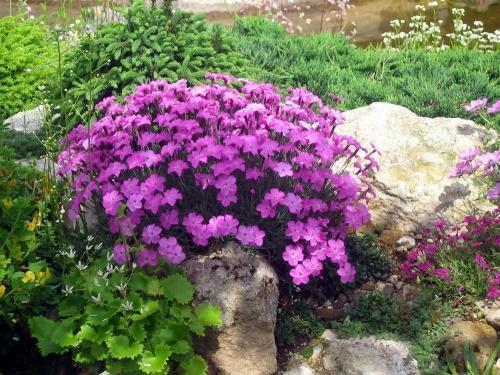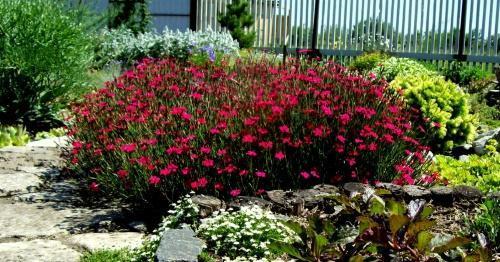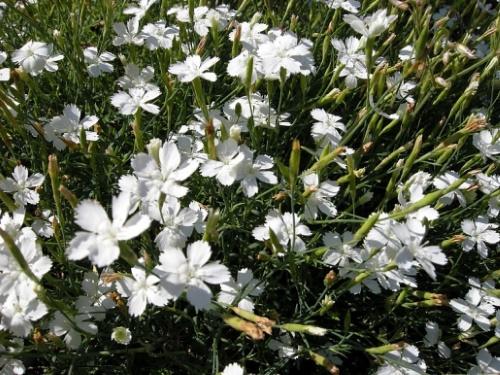A compact alpine carnation on your alpine slide: what you need to know about growing a flower
 Low-growing flowering plants give special charm to flower beds and compositions. Their small bushes, completely covered with small inflorescences, immediately attract the eye. Take, for example, the alpine carnation - unlike its larger relatives, it has a compact size and a very flexible character, since it can grow even on poor soils.
Low-growing flowering plants give special charm to flower beds and compositions. Their small bushes, completely covered with small inflorescences, immediately attract the eye. Take, for example, the alpine carnation - unlike its larger relatives, it has a compact size and a very flexible character, since it can grow even on poor soils.
What does the plant look like?
Alpine carnation grows in the form of round bushes, consisting of thin stems no more than 25 cm high. They have narrow thin leaves of gray-green color. With the onset of summer, the bushes are covered with small, but very fragrant and beautiful inflorescences up to 4 cm in diameter. They are formed by five toothed petals, slightly corrugated. The plant blooms profusely until August, but at the end of summer you can see flowers on the bushes, albeit in a single amount. The color of carnations can be very diverse: from snow-white to deep purple.
The root system of a carnation is a long rod that grows to the sides over time. It accumulates nutrients and "feeds" the aerial part of the bush, thanks to which it quickly turns into a large, up to 50 cm in diameter, grass cushion.
 After the end of flowering, elongated seed bolls are formed in place of the inflorescences. When they are fully ripe, they open four doors at the top, and from them round seeds spill out onto the ground. So perennial alpine carnation and reproduces without the participation of a grower. As for the mother bush, its life span is relatively short and does not exceed 4 years.
After the end of flowering, elongated seed bolls are formed in place of the inflorescences. When they are fully ripe, they open four doors at the top, and from them round seeds spill out onto the ground. So perennial alpine carnation and reproduces without the participation of a grower. As for the mother bush, its life span is relatively short and does not exceed 4 years.
Wild species of Alpine carnation grow freely on limestone rocks among the mountain slopes in the Alps, as well as in Austria, Italy and Slovenia. In horticultural floriculture, its hybrid varieties are most often used - they are more adapted to home growing.
Growing features
The unpretentiousness of the alpine carnation is manifested by the lack of requirements for the nutritional value of the soil, moreover, too "rich" land will only harm the plant, especially with an excess of organic matter. In such conditions, the bushes age quickly and endure the winter worse.
The best soil option for growing carnations is a rocky area with an admixture of neutral sandy soil.
The abundance of flowering depends on the planting site. The plant should be planted on the sunny side of elevated areas, where there is a lot of light and moisture does not stagnate.
Alpine carnation care is simple and includes:
- Watering as needed.
- Weed removal.
- Periodic dressing with mineral preparations, but no more than three times per season.
- Introduction compost before winter.
- Pruning bushes after flowering.
The flower propagates by seeds, cuttings or layering, but the first method is used most often.